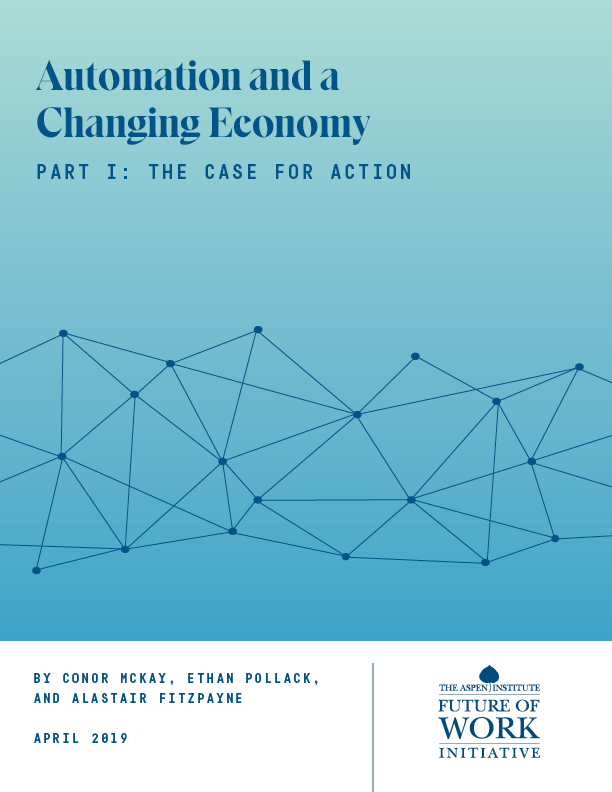Automation and a Changing Economy is divided into two sections. Part I, The Case for Action, explores how automation impacts the economic security and opportunity of the American worker.
Introduction
Technology fuels our economy, captures our collective imaginations, and promises extraordinary possibilities. It permeates almost all aspects of our lives. From electrification and the internal combustion engine, to search engines and smartphones, technology has changed how we travel, access information, buy products, and communicate with each other. As technology changes our personal lives, it also changes work. For generations, economic change has replaced products, jobs, and industries with innovative new models. The American economy has transitioned from agrarian to industrial, service to digital, and with each evolution, America has prospered even as it grappled with the profound challenges of change.
The American ideal embraces the promise that economic progress can create an inclusive society in which prosperity is broadly shared. Work is more than simply a way to earn a living. It gives structure, dignity, and purpose to our lives. For this reason, workers should not be treated as a cost of doing business but recognized for their productivity and creativity.
For too many Americans, the promise of work is not being kept. New technologies are creating great wealth for some, but we are simultaneously experiencing historic income and wealth inequality. Without robust policies and strong institutions, new innovations risk exacerbating the economic insecurity and political and civil divides that we are experiencing today.
Emerging technologies, including artificial intelligence, machine learning, and advanced robotics, have the potential to automate many tasks currently performed by workers. Historically, automation has been an important ingredient driving economic growth and progress. Automation has enabled us to feed a growing population while allowing workers to transition from subsistence farming to new forms of work. Automation helped move us from a craft system to mass production, from blue-collar to white-collar to “new-collar” work—with better work, higher wages, more jobs, and better living standards. Similar to past innovations, these new technologies offer the potential to help us meet human needs while supporting new jobs and industries never before imagined.
However, automation can also have negative effects on individuals and communities. Those who lose their jobs suffer economic, social, and psychological hardship. Communities that relied on single industries that have been automated have struggled to recover. New jobs are being created, but their geographic distribution and skill requirements often make them inaccessible to the individuals and the communities where those whose jobs were lost. This dislocation has played a role in exacerbating America’s economic, political, geographic, and social divides.
The answer to the dislocations that can result from automation should not be to stifle innovation. Policies and reforms should encourage both the development of new technologies and the promise of work. Workers need access to the opportunities technology creates. Policymakers and employers can help by providing access to skills training, ensuring the availability of good jobs, and improving the systems that are in place to help those who will transition from declining to growing occupations.
While there are many unanswered questions about what the future holds, this report attempts to explain how automation impacts the labor market and how to better prepare American workers to benefit from the changes to come.
The report is divided into two sections. Part I, Automation and a Changing Economy: The Case for Action, explores the history of automation and how it may impact the economic security and opportunity of the American worker in the future. This report reaches the following conclusions:
- While automation boosts economic growth, creates jobs, and improves living standards, it can also present serious challenges for workers and communities, including job displacement, disruptions to local economies, changing skill needs, and rising inequality.
- Investments in education, training, and the social safety net, along with a social contract between employers and workers that provided workplace benefits and protections, have helped mitigate automation’s negative impacts in the past and helped workers succeed in the changing economy.
- Recent challenges highlight the consequences of limited supports for vulnerable workers. Disinvestment in public and private sector training, a weakened public safety net, and reduced access to workplace benefits and protections have contributed to a slow and painful economic adjustment. Rising inequality and insecurity has left the country unprepared to weather future disruption.
- Artificial intelligence and other new technologies may lead to deeper, faster, broader, and more disruptive automation. Automation need not be any more disruptive in the future than it has been in the past to warrant increased policy intervention, but action is particularly important because the U.S. economy could soon experience increased automation disruption.
Part II of this report, Automation and a Changing Economy: Policies for Shared Prosperity, outlines a program to address automation’s challenges and opportunities. Success is achievable, but it requires an all-of-the-above approach, from targeted interventions to those with systems-level impact; from smaller place-based policies to reforms to national-level social safety net programs. While automation is one of the economic challenges facing American workers, potential solutions can address multiple problems including wage stagnation and income inequality.
Technology is not destiny—the impact of innovation on the American worker is mediated by policy choices and how institutions, such as employers, worker organizations, non-profits, and philanthropies respond to these challenges. By helping workers take advantage of new opportunities and assisting workers who are acutely impacted by automation return to stable work, we can promote greater opportunity and broadly shared prosperity for all.
Read Part I: The Case for Action



